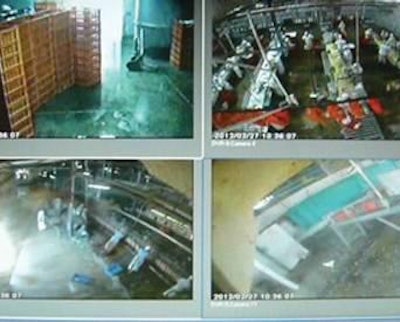
Many poultry companies locate their headquarters in the same place as their processing plant, but this does not ensure contact between plant and company managers, as some companies operate a night-, rather than a day-, shift for the processing operations.
Some companies choose to locate their headquarters in cities, a long way from the processing plant, yet even if the processing plant is within easy traveling distance, there could still be the problem of night shifts, so making direct contact difficult.
Yet these poultry companies succeed despite the lack of continual direct contact. One of the ways that a check is kept on the processing operations is though the use of video monitoring, with cameras being installed at strategic points to ensure that the plant is running smoothly.
Typical installation points may include the unloading and storage areas, hanging on the overhead conveyors, the scalding and plucking areas, the evisceration area, the exit from the chiller in the grading and packing section, and the entrance to the cold room and dispatch area.
Ensuring the smooth completion of operations is important, and video monitoring can offer a good overview, but it is not the end of the story.
With this level of monitoring, enough information is available to know whether the plant is functioning well, yet what is observed is simply a series of activities along the processing line.
Greater scrutiny in the processing plant
Several other parameters also need to monitored, and these include:
- Product quality
- Yield
- Employee safety and efficiency
- Rational water consumption
- Energy use on the processing line
- Proper adjustment of equipment to bird size
- Keeping product loss at acceptable levels
- Number of dead-on-arrival birds
- Poorly bled carcasses
- Bruised and damaged carcasses
- Over-scalded birds
- Birds damaged during plucking
- Feed- or bile-contaminated birds
Addressing these challenges offers various operational and economic advantages for processing companies, but doing so is not always easy.
For example, when a company has poultry processing plants in a number of locations - including possibly in other countries - then audit teams must travel. There is a double cost associated with sending audit teams – the financial cost of travel, but also the emotional cost.
Some companies choose to use outside consultants to evaluate pre-slaughter and processing activities, yet this also frequently results in the expense of flights, lodging and food.
However, with today’s technology, much of this work could be done virtually, and in other industries it is already happening. Think of remote surgery, or telesurgery, where the surgeon and patient are not physically in the same location, and physical distance is immaterial.
To apply a similar approach to the final stages of chicken production, all that is needed is a good Wi-Fi connection that does not pause, a camera that can be connected to the Wi-Fi system, two smartphones, and two computers.
How does it work?
The plant that is being inspected must choose someone to be responsible for the camera and the smartphone, which must both be connected to the computer via Wi-Fi. The expert hired to evaluate operations can be located anywhere in the world, but must also have a smartphone and a computer.
From his or her office, the expert can give instructions to the nominated person, who can move around the farm, processing plant, or any part of the company, transmitting images, sound and any other data. These can be evaluated by the expert in real time, who can then make recommendations, should they be necessary, as to how changes can be made to improve yield and quality.
In addition to being viewed live, any video recordings and photographs will be stored on the computers. Depending on the extent of the review and evaluation that has been requested, a presentation can, if needed, be subsequently made using this recorded material.
A teleconference can be conducted and corrective action and recommendations made. An activity schedule can also be drawn up, and any recommendations that are implemented can be monitored to ensure that they leading to the expected results.
This approach can be applied to any area of a company’s activities to ensure that they are being properly carried out. Just as air traffic controllers do not need to be close to each and every airplane that they monitor, with today’s technology, neither do poultry plant inspectors.
Those that carry out remote monitoring do, however, still need to be highly trained in integrated production management and be able to lead the inspection process.




.jpg?auto=format%2Ccompress&fit=crop&h=167&q=70&w=250)












